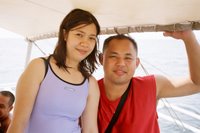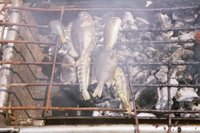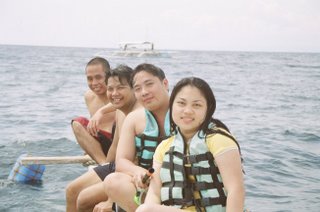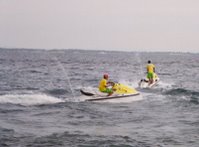Island hopping is a bustling tourism activity for locals and foreigners in Mactan. The itinerary would include a kick-off point in one of the focal boat stations (Maribago, Marigondon or Cordova) and close encounters of the small islands off the eastern coast of Mactan. The major attraction is not the islands themselves but the marine flora and fauna surrounding the islands. Island hopping as the popular name for this activity is a misnomer. The reasons are that the stopovers are limited to two or three islands the most and tourists do not actually set foot on the islands to roam and explore but go snorkeling in  their reefs instead.
their reefs instead.
Last October 28, I had been invited by two of my college friends, Erisa and Val, to an island hopping activity. I was told that Edson and Juvy along with Val’s officemates from Sykes would be going too. I accepted the invitation and decided to have considerations for photo opportunities. This would mean no swimming for me. 
We set off from Maribago and amidst the hurly-burly of so many boats waiting for ‘hoppers’ like us, we headed for our first stop: Gilutongan Marine Sanctuary.
Gilutongan Marine Sanctuary
This marine sanctuary is still part of the Olango Island reef complex. This island is administered by the Municipality of Cordova. Like the rest of the Olango reefs, the ecosystem around Gilutongan is very much diverse. The people of Gilutongan are still undergoing the struggle of regaining the natural abundance of its surrounding seas. Years of over-fishing and use of destructive fishing methods caused the coastal resources steady decline. Making amends with the sea is a must in spite of the bitter pill that they must swallow. Before anchoring near the marine sanctuary, we headed to the northern part of the island to retrieve the all-important coal grill. We have not escaped the pangs of slight un-preparedness. Our boatmen offered help by retrieving their grill from another boat anchored north of Gilutongan. While waiting for the grill, we observed a large purple jellyfish beside our boat. It was by far one of the biggest jellyfishes I have seen. This brainless Cnidarian (phylum Cnidaria) is floating aimlessly in the shallow waters and we took time taking pictures.
Before anchoring near the marine sanctuary, we headed to the northern part of the island to retrieve the all-important coal grill. We have not escaped the pangs of slight un-preparedness. Our boatmen offered help by retrieving their grill from another boat anchored north of Gilutongan. While waiting for the grill, we observed a large purple jellyfish beside our boat. It was by far one of the biggest jellyfishes I have seen. This brainless Cnidarian (phylum Cnidaria) is floating aimlessly in the shallow waters and we took time taking pictures. The actual marine sanctuary in Gilutongan is marked by buoys. Boats are not allowed beyond them. Swimming is also limited outside the buoys during low tides. The swimmers may cause damage to the rich coral ecosystem of the sanctuary when the water is shallow.
The actual marine sanctuary in Gilutongan is marked by buoys. Boats are not allowed beyond them. Swimming is also limited outside the buoys during low tides. The swimmers may cause damage to the rich coral ecosystem of the sanctuary when the water is shallow. When we arrived at the sanctuary, almost everyone went snorkeling. One of our boat's crew was a boy. He also dove like the others. Every time he surfaced, he would approach the rear of the boat. It was then when I observed that the boy was actually fishing. Lucky for him, the fishes he speared were small and easily identifiable as common species. Their fate led them to the coal grill.
When we arrived at the sanctuary, almost everyone went snorkeling. One of our boat's crew was a boy. He also dove like the others. Every time he surfaced, he would approach the rear of the boat. It was then when I observed that the boy was actually fishing. Lucky for him, the fishes he speared were small and easily identifiable as common species. Their fate led them to the coal grill.
<span style="font-family:verdana 
There were already many rented boats in the sanctuary. Ours was the only boat with no foreigners aboard (save for Chaw who is easily mistaken as Korean, see image above, second from right). Leading the tourist trail were actually South Koreans. The Philippines seemed to be an irresistible magnet for them. As a proof, 12% of their country's population visited the Philippines in 2005. Gilutongan is a popular tourist destination for them.
Appetite is always near voracious during recreation activities at sea. This may be due to the saltiness of the seawater smacked and drank during swimming.
Our lunch consisted of puso or hanging rice (rice cooked in coconut leaf pouch), pork lechon, chicken lechon (more apt would be lechon baboy and lechon manok) and dinuguan (pork meat and innards stewed in pork blood). All the calories burned in the hours of kicking and paddling were easily cancelled by our vein-constricting meal.
After lunch and about an hour of trying to cancel again the calories gained (read: kicking and paddling, again!), we decided to go to Sulpa.
Sulpa Island
I have long recognized Sulpa simply by the small opening in its tip that offers a view of the opposite side of the small island. It was only by this time that I have known its name. By surfing the net, I have found out that Sulpa is the least visited of the local island destinations and that there is a small cave that a “snorkeler” can swim through to the other side of the island.
 An exploration team was then set up. Our boat could not approach the island due to the shallow water. Sea urchins actually plague the area. The black spines are easily noticeable in the lush green marine vegetation. The members of the exploration team were giddily excited to set foot on this island.
An exploration team was then set up. Our boat could not approach the island due to the shallow water. Sea urchins actually plague the area. The black spines are easily noticeable in the lush green marine vegetation. The members of the exploration team were giddily excited to set foot on this island.  Donning smiles and grins, all headed to the island’s tip.
Donning smiles and grins, all headed to the island’s tip.
After several minutes, they all headed back to the boat. The smiles were gone. Pained expressions and irritated looks covered their faces. When everyone has boarded the boat, some were scratching their legs and thighs. They were actually itching.
Our boatmen told us that the young jellyfishes that usually blighted that area may well be the cause of their few-minute-itches.
In hindsight, I now knew why Sulpa is the least visited of the islands surrounding Mactan.
With the frustrations of not setting foot in Sulpa, it was decided to spend the remaining hours near the beaches of Mactan.
Dakit-dakit Islet Our boatmen brought us near a dive spot close to an islet they called Dakit-dakit. This islet had some remnants of concrete cottages. They told me that there were in fact cottages in the islet before. However, they were destroyed by strong typhoons winds. The owner decided not to have them rebuilt.
Our boatmen brought us near a dive spot close to an islet they called Dakit-dakit. This islet had some remnants of concrete cottages. They told me that there were in fact cottages in the islet before. However, they were destroyed by strong typhoons winds. The owner decided not to have them rebuilt. There were also some attention grabbers in the area. These were the curry-colored jet ski drivers trying to show off their skills by crisscrossing and cutting through water.
There were also some attention grabbers in the area. These were the curry-colored jet ski drivers trying to show off their skills by crisscrossing and cutting through water.
Some were actually interested to enjoy the perils of the banana boat ride. The jet ski drivers told us that a 30-minute ride would cost P3000.00. There was a consensus to ride at least for 15 minutes. A deal was stricken with the banana boat driver. However, he took a few minutes leave to refuel. The few minutes turned into many minutes. The excitement for the banana boat ride wore out and eventually, we decided to all it a day.
The seemingly outrageous prices of these amenities may well be the cause of a slow death on local tourism. With the increase of foreigners in the area, local businessmen took the opportunity to milk more money by increasing their prices making them too expensive for the average local tourist.
Not easily discouraged by the snobbish curry-clothed men, Val while driving home decided to peek at Portofino. Eventually, we made the banana boat ride a reality. Our analysis of the physics of banana boat riding and my struggles in climbing that floating oversized banana is another story.

